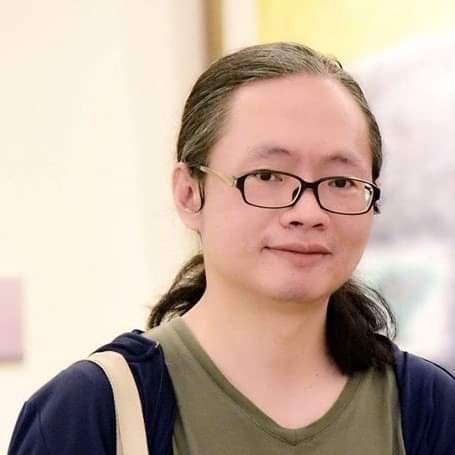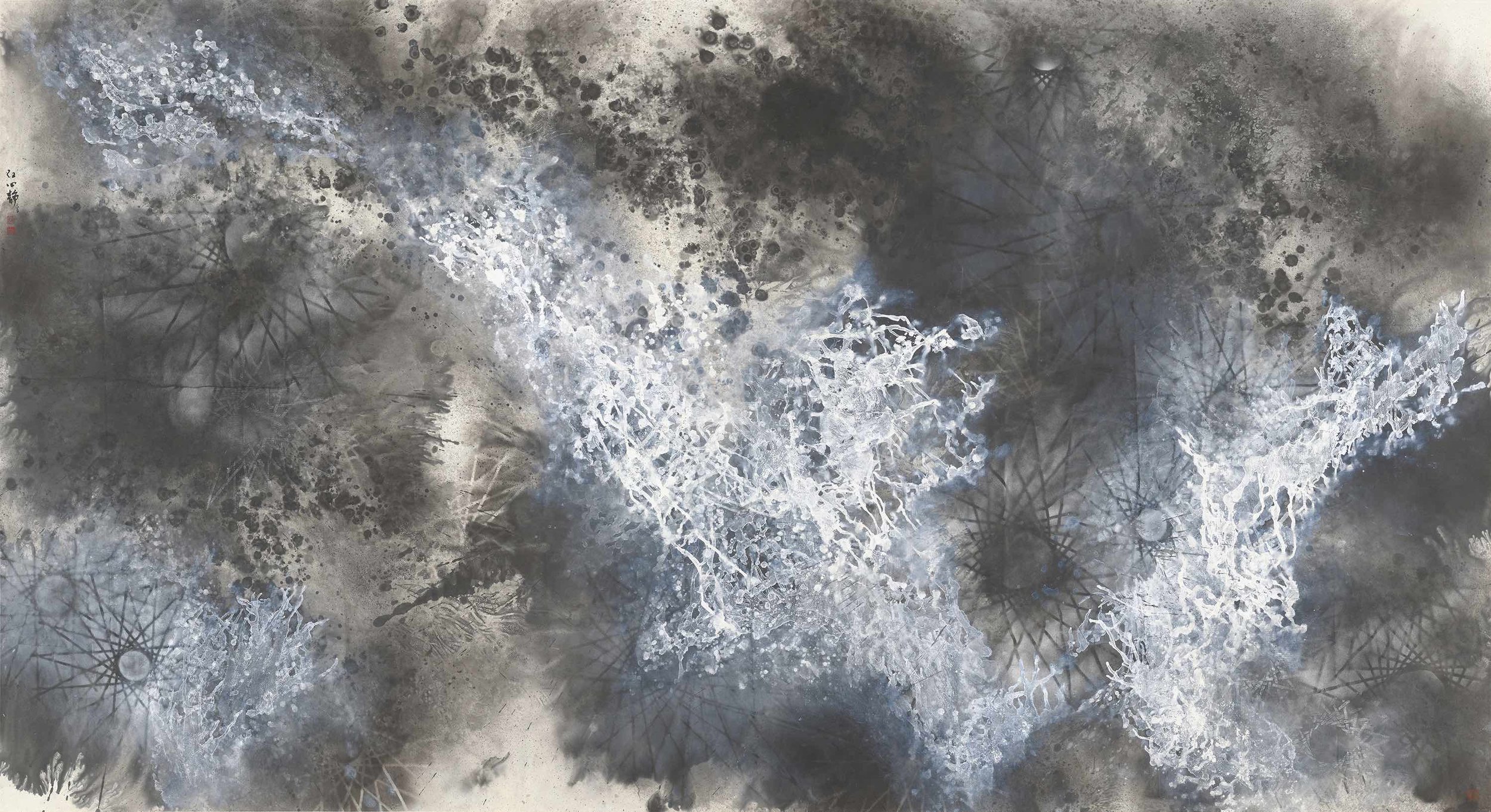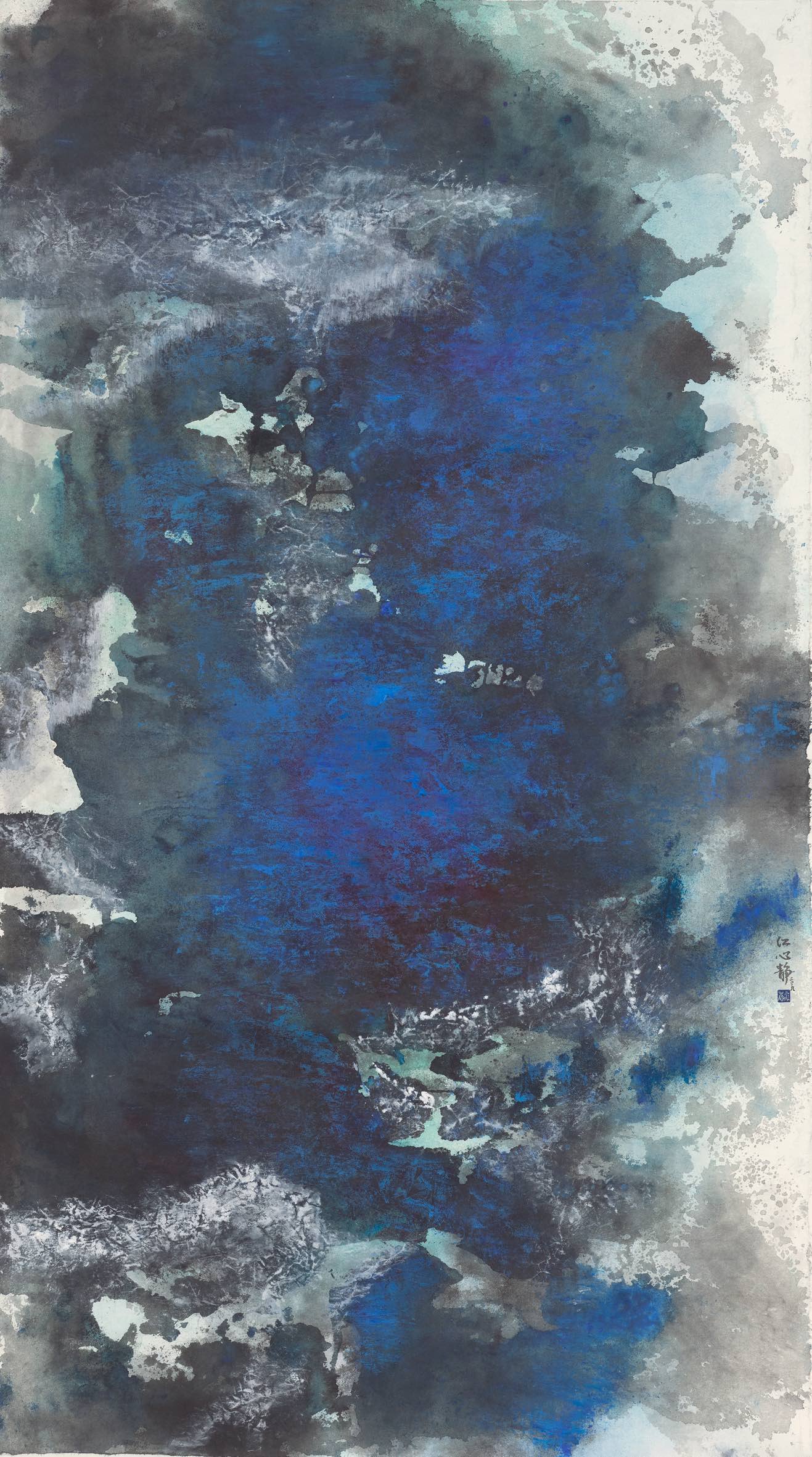文/ 青木 Aoki·策展人·台灣師範大學美術研究所水墨創作理論組博士生
梅洛-龐蒂 (Maurice Merleau-Ponty, 1908-1961)在《知覺現象學》書中提及:
我們需要重新喚醒對世界的體驗,因為我們藉著自己的身體在世界上存在,並透過我們的身體來感知世界。當我們透過這種方式重新與自己的身體、並與世界連結,我們也將重新發現自己,因為藉自己的身體感知,身體就是一個自然的我,就是知覺的主體。
江心靜以其個人有限之軀,在1998-2001年(與好友林存青)以單車環遊世界五大洲三十多國,透過走訪名山勝景,旅遊各國美術館、博物館等方式來感知這個世界與重新發現自己的身體,並於過程中積累其豐厚個人生命廣度與厚度,然後再由文學領域跨界進入抽象繪畫的藝術領域。
而抽象繪畫也著重藝術家的身體與畫面之間的關係,是藝術家「帶著他的身體」進入畫面之中,然後使之成為藝術作品。藝術家江心靜思網系列的許多大尺幅抽象水墨繪畫〈隱形的山林〉,使用水拓、滴、流、灑或噴等技法於畫面上,或許可以視為透過身體介入畫面之後所產生的多樣可能性作用,使之得以實現不同意義上的身體延伸。
她以其身體介入畫面的「當下」,作為參考座標,「過去」是記憶,「未來」是想像,使其在這心靈的層面上超越此身之有限。
2020-江心靜 - 思網系列-隱形的山林-292x159 cm- 水墨設色紙本
Figure 1: Chiang Hsin-Ching. “iNetwork Series: Invisible Forest”, 2020. Ink, color on paper. 159x292 cm.
東方意識流
在西方「意識流」(Stream of consciousness)原先出現於心理學領域,後來逐漸發展於文學、戲劇等不同藝術領域。隨著全球化時代來臨與後現代主義「多元化」的時代精神特質,促使意識流至今的影響力與日俱增,在當代藝術開始廣泛運用「意識流繪畫」來作為一種新的繪畫探索方式。
美國心理學家威廉·詹姆斯(William James,1842-1910)將人類心靈(意識)比喻成一條河流。他認為意識既然是流動的,所以人於其中可以注意自身所感興趣的部分,並將之挑選出來構成自己的內心世界;而法國哲學家亨利·柏格森(Henri Bergson,1859—1941)則提出意識流的「心理時間」觀點,來取代現實生活中的「物質時間」。佛洛伊德(Sigmund Freud,1856—1939)則是予以補充說明「意識流由潛意識決定」。三人所提出的觀點構成了意識流的理論基礎。
二十世紀隨著全球化時代的知識傳播,西方意識流逐漸影響亞洲當代藝術的發展現況,並隨著後來「全球在地化」的主流發展趨勢,逐漸轉化成為具有亞洲區域特色的「東方意識流」。
意識流在西方二十世紀初期在現代文學領域,發展成為具有內心獨白、內心分析(理性)、自由聯想、時間與空間的錯置顛倒、詩歌與音樂化的象徵性等文學寫作技巧,後來廣泛影響到亞洲的現代文學等不同藝術領域,並隨著全球在地化的發展趨勢,逐漸影響現今繪畫領域,使之發展成為具有東方意識流特色的當代繪畫表現形式之一。
東方意識流繪畫在強調直覺、感受性與形塑人物內心世界的心理層面,相似於西方;在內心獨白、自由聯想、時空交錯與情感跳躍等藝術技巧的使用,也相似於西方。有別於西方意識流之處在於美學上,東方意識流其一是融入更多東方式的思維與傳統人文精神內涵,其中保有對於社會現實層面的理性思考,與探討深度層次的人文社會結構的時代變遷議題。
2019 -江心靜- 思網系列-昨日之島 - 180x 95 cm ×3 pieces -水墨設色紙本 Figure 2: Chiang Hsin-Ching. “The Island of the Day Before”, 2019. 180x95×3 cm.
2019 -江心靜-思網系列-寒冰-79x142 cm-水墨設色紙本. Figure 3: Chiang Hsin-Ching. “Frigid Ice”, 2019. 142x79 cm.
就江心靜個人而言,現階段藝術涵養來源於東方傳統人文主義精神、青年時期單車環球壯遊的生命歷程、中年時期研修當代水墨與歐陸哲學,與對於自身所處時代社會議題的人文反思關懷,成就其探索記憶維度的「思網系列」。對於西方意識流於她藝術創作方面影響,僅止於形式與技巧上的運用,並以東方式的人文精神內涵為心靈依歸準則,從對於現實生活思考感受為創作出發點,來定位其意識的流向發展,其藝術是「朝向現實世界,又同時面向內心世界」,所以江心靜藝術上的意識流,可以說是具有全球在地化後的亞洲河床上流動的「東方意識流」。
差異哲學
「藝術是體現存有之道」,而「存有」一詞意指存在活動。那致使藝術作品成為彼此有別的動力,乃根源於「存有本身即是差異」,而藝術作品則是存有已逝的蹤跡。所以德勒茲(Gilles Deleuze,1925-1995)此一美學觀點合理詮釋了抽象繪畫彼此之間差異之所在。
藝術體現存有,不重複既存現實,而要轉化人的認知與慾望。所以攝影師杉本博司也曾說過「藝術是種技術,將肉眼不可見的精神世界化為物質的手段。」所以藝術是將不可見使之可見的一種過程,透過物質性的媒材作為轉換的媒介。
並且藉由在差異之中,萃取真實存有永不止息的臨現與續存。重要的是藉由作品本身的差異,返回存有的真實 (靈光),再度激起生命綿延不絕的創作欲望(創作者與觀者都是如此)。而形成藝術品「獨特性」的原因之所在,即是創作者在某一時空的創作當下能夠清楚意識到,自身生命狀態的真實存有(即「差異性))之存在。
觀賞江心靜的思網系列畫作的過程之中,好似時常能有上述類似經歷,彷彿從高空俯視山川大地、或是望向一望無際海洋潮浪、或是淹沒於數位資訊時代的洪流之中....,於其畫作之中感受生命狀態真實存有的悸動或崇高....,如一首詩般的美好期盼,並於其中蘊藏著自然宇宙奧妙與真理的永恆追尋。
關鍵字 : 知覺現象學、東方意識流、全球在地化、差異哲學、思網系列
參考文獻
江心靜,《永不停歇的旅人》,台北:木馬文化,2015。
劉千美,《差異與實踐—當代藝術哲學研究》,新北:立緒,2001。
何兆基,<知覺的身體與被知覺的世界-當代藝術的身體話語>,《二十一世紀雙月刊(2011年4月號 總第一二四期)》,香港中文大學,2011。
林文軒,<王蒙意識流小說淺論-兼析中西意識流文體之異同>,《展望與探索月刊6卷8期(97/08)》,新北:法務部調查局,2008。
木心,<第六十三講:意識流>,《大英圖書館》https://www.britishlibrary.cn › mu-xin-stream-of-consciousness,檢索日期 : 2021/1/31。
—————————————————————————————————————————————————————————————————————
Poetic Aesthetics of Eastern Stream of Consciousness
Author: Aoki - Curator, NTNU College of Arts, Doctoral Candidate for Art Creation and Theory in Ink Painting
Maurice Merleau-Ponty (1908 - 1961) said the following in his book Phenomenology of Perception:
In the same way we shall need to reawaken our experience of the world as it appears to us in so far as we are in the world through our body, and in so far as we perceive the world with our body. But by thus remaking contact with the body and with the world, we shall also rediscover ourself, since, perceiving as we do with our body, the body is a natural self and, as it were, the subject of perception.
Chiang Hsin-Ching tested her limited physical body by biking around the world on a journey to more than 30 countries and 5 continents with her friend Tsun-Chin from 1998 to 2001. Her worldly travels to distant mountains and sceneries, and to art galleries and museums, heightened her awareness of this world and helped her rediscover her body. Her cumulative experiences both enriched and expanded her individual life. Later on in her life, she transitioned away from her career in literature to delve into abstract painting.
Abstract painting accentuates the relationship between the artist’s body and the painting surface. An artist “brings their body” onto the surface and transforms it into a piece of art. Many of the large abstract ink paintings (Figure 1) in the iNetwork Series use techniques such as shuotuo (“water-rubbing”), dripping, spreading, sprinkling, and spraying. These techniques are the result of the body being embedded into the painting surface, opening up a diverse set of possibilities that allow for different, meaningful extensions of the body.
Chiang inserts her body into the “now” of the painting to act as guiding coordinates, with her “past” being her memory and the “future” her imagination. It is on this spiritual level that she transcends the limits of her physical body.
Eastern Stream of Consciousness
In Western society, “stream of consciousness” made its first appearance in the field of psychology, and later spread to various fields of art like literature and theater. The influence of stream of consciousness grows steadily to this day thanks to the zeitgeist of globalization and postmodern “diversity”. In contemporary art, “stream of consciousness painting” is widely employed as a new means of discovery through painting.
American psychologist William James (1842 - 1920) was the first to describe the human spirit (consciousness) as a “river” or “stream”. He argued that seeing as consciousness is fluid, humans can be aware of their interests and use them in structuring their own internal world. French philosopher Henri Bergson (1959 - 1941) proposed the idea of a “psychological time” which takes the place of the physical time we experience in real life. Sigmund Freud (1856-1939), on the other hand, adds that the “unconscious mind drives the stream of consciousness”. The arguments of these three scholars constitute the foundation of stream of consciousness theory.
The vast dissemination of information from 20th century globalization led to Western stream of consciousness making a steadily larger impact on the development of modern art in Asia. Combined with the advent of the mainstream trend towards “glocalization”, an Eastern stream of consciousness with Asian characteristics began to take shape.
With regards to 20th century Western literature, stream of consciousness evolved into literary devices such as interior monologue, internal analysis (rationality), free association, time and space displacement, and symbolism in poetry and music. All of these later extensively influenced modern Asian literature and other art fields in Asia. With the growth of glocalization, these techniques thus began to transform modern painting in Asia into a contemporary style of artistic expression with characteristics of Eastern stream of consciousness.
Similar to the Western variant, Eastern stream of consciousness painting emphasizes the psychological phenomenons of intuition, perception, and internal characterization. It is also not unlike Western stream of consciousness in that it utilizes artistic techniques such as interior dialogue, free association, time and space displacement, and emotional leap. However, Eastern stream of consciousness differs from the Western version when it comes to aesthetics. Firstly, Eastern stream of consciousness integrates more Eastern ways of thinking and traditional humanistic spirit, among which are the rational consideration of social reality and the exploration of the deep layers of human societal structure as it changes over time.
Chiang Hsin-Ching’s The Island of the Day Before (Figure 2) in her iNetwork Series uses Eastern stream of consciousness to expand the psychological time and space in her painting, and to narrow the gap between her internal spiritual world and her external reality. She also utilizes artistic iconography to reflect, and by following the model of traditional Eastern humanistic spirit, she can attend to and address current major social issues. All this helps to establish the aesthetic domain of her personal internal world in the painting, leaving room for imagination and giving viewers an opportunity to interact with and be involved in her art.
The second way in which Eastern stream of consciousness differs in terms of aesthetics is that the individual controls the surface layer of awareness to take command of the deeper domain of the unconscious mind. A talented artist must have a robust, rich subconscious. As such, the awareness techniques artists use in the moment of creation must be precise and consummate. Only then can they choose to either control or give free rein to their consciousness (to allow the unconscious mind to be expressed freely) in the exact instant the unconscious creation is undergoing rapid change. The final act is to complete the painting while still in control of one’s consciousness. Artists who employ Eastern stream of consciousness have an outstanding grasp of how to “balance the conscious and unconscious”. We can see very clear evidence of this in Chiang Hsin-Ching’s work Frigid Ice from her iNetwork Series.
As for Chiang Hsing-Ching as a person, the source of her artistic self-discipline at the present stage comes from a spirit of traditional Eastern humanism, her experiences traveling the world by bike in her youth, her study of modern ink painting and French philosophy in her middle years, and her humanistic reflection and concern for the social issues of her lifetime. All of this has crescendoed into the iNetwork Series which explores the dimension of memory. Western stream of consciousness only influenced the form and techniques she used in her paintings. However, she based her contemplations of real life experiences on Eastern humanistic spirit. They became the starting points of reference that helped direct the flow of her consciousness. Her art “looks outward to the material world, but also turns inward toward the internal world”. Stream of consciousness in Chiang Hsin-Ching’s art can thus be said to be an “Eastern stream of consciousness” that flows through a glocalized Asian river bed.
Philosophy of Difference
“Art is the embodiment of being” where “being” is the act of being. The force that drives the difference between works of art originates in the idea that “being itself is a difference”, and that works of art are the vestiges of a being which has already disappeared. Therefore, Gilles Deleuze’s (1925 - 1995) aesthetics provide a reasonable explanation for where the differences lie in abstract paintings.
Art embodies being and does not replicate an existed reality; it seeks to transform a person’s cognition and desires. The photographer Hiroshi Sugimoto once said, “Art is technique: a means by which to materialize the invisible realm of the mind.” Thus, art is a process of making the invisible visible, using a physical medium as a vehicle for transformation.
From within difference, art also extracts the perpetual presence and persistence of true being. Most importantly, differences in a work of art itself help it return to the authenticity (“aura”) of being, and reinvoke within it life’s neverending desire for creation (both in the creators and the viewers). Any work of art may exhibit “Uniqueness” when, in the moment of its creation, the creator is fully aware of the existence of their own life state’s true being.
When viewing Chiang Hsin-Ching’s iNetwork Series, one may often encounter the aforementioned experiences, feeling as if high up in the sky peering down upon the mountains, the river, and the land; gazing at ocean waves that extend far off into the distance; or becoming inundated in the flood that is the age of digital information. One may feel the pulse or the splendor of life and true being. One may feel a hope, beautiful and poetic, and from within the brush strokes, experience the marvels of the natural universe and the eternal search for the truth.
Keywords: Phenomenology of Perception, Eastern stream of consciousness, glocalization, philosophy of difference, iNetwork Series
References
Chiang, Hsin-Ching. The Traveler Who Never Stops, Taipei: ECUS Publishing House, 2015.
Liu, Johanna. Difference and Praxis in Contemporary Philosophy of Art. New Taipei: New Century Publishing, 2001.
Ho, Siu-kee. “The Perceiving Body and the Perceived World--A Discourse on Bodyness in Contemporary Art”. Twenty-First Century (Number 124, April 2011). The Chinese University of Hong Kong, 2011.
Lin, Wen-Hsuan. “An Introduction of Wang Mon's Ideological Novels--Analyzing the Differences and Similarities between Chinese and Western Ideological Novels”, Prospect and Exploration (Vol. 18 No. 11, August 1997). New Taipei City: Ministry of Justice Investigation Bureau, 2011.
Mu, Xin. “Talk No. 63: Stream of Consciousness”. British Library. Retreived from https://www.britishlibrary.cn/zh-cn/articles/mu-xin-stream-of-consciousness on January 31, 2021.




